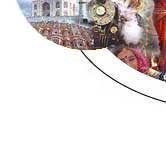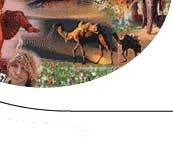|
||||||||||||||||
|
||
| MUMBAI |
|
CITY OF DREAMS |
 Mumbai’s
very name conjures up a host of visions: of glamour and megastars
who hold millions in thrall, of some of the largest and worst slums
in the whole of Asia, of industrialists and business houses, of
a multifarious futuristic lifestyle that is likely to become even
more intense as the city moves closer and closer to becoming the
world’s second largest metro by the year 2015…. Mumbai manifests
a strong Western streak amidst the traditional Maharashtrian milieu.
This is probably due to its being literally the Gateway of India,
the point of arrival for most visitors from the West.
Mumbai’s
very name conjures up a host of visions: of glamour and megastars
who hold millions in thrall, of some of the largest and worst slums
in the whole of Asia, of industrialists and business houses, of
a multifarious futuristic lifestyle that is likely to become even
more intense as the city moves closer and closer to becoming the
world’s second largest metro by the year 2015…. Mumbai manifests
a strong Western streak amidst the traditional Maharashtrian milieu.
This is probably due to its being literally the Gateway of India,
the point of arrival for most visitors from the West.
LOCATION
Mumbai (formerly Bombay), situated on the western coast of India, is the largest metropolis of the country. It is the capital of one of India’s most advanced states, Maharashtra.
CLIMATE
Mumbai is pleasant during the winter (November–March) and hot during summer. The temperature is on the rise from the month of March until the monsoons break out in mid-June, which goes on until September. October offers a relief from humidity and heat.
VISITING TIME
Throughout the year.
THE PAST
The enigmatic city of Mumbai was a cluster of seven islands of Koli fishermen who lived on the shores of the Arabian Sea and worshipped Mumbadevi. Hence, the place got the name Mumbai. Mumbai was given by Portuguese as dowry to Charles II of England when he married Catherine. The group of seven island was leased to the East India Company who offered freedom of business and religion to persons who came and settled here. Initially a few Parsis and Gujarati came but soon a sizeable population began to thrive here. This was way back in the 17th century.
TOURIST ATTRACTIONS
Gateway Of India
This 26 metres high stone archway is the first landmark of Bombay a visitor sees when arriving by ship. Designed by Writtet in the 16th century, it was built to commen/morate the visit of King George V and Queen Mary to India in 1911. This crypto-Moresque archway welcomed numerous viceroys, governors and top civil servants as they disembarked by launch from their P&O steamers. An equestrain statue of Chhatrapati Shivaji and statue of Swami Vivekananda have been installed here.
Afghan Church
Dedicated to the British soldiers who fell in the Sindh and Afghan campaigns of 1838 and 1843, this church also known as St. Johns Church was built in 1847.
Chowpatty Beach
A popular beach where celebration of festivals such as Coconut Day and the Ganesh Chaturthi immersions take place. Besides little kiosks selling Bombay's special snacks, Bhelpuri & Kulfi (local ice crem) one can find professional massesurs, pony leaders, beebee-gun shooting galleries, contortionists, balloon sellers, flower-girls and lots more. On the beach are statues of India's freedom fighters, Lokmanya Tilak and Vithalbhai Patel who symbolise the freedom struggle.
Haji Ali Mosque
The tomb of a Muslim saint who died while on pilgrimage to Mecca. It is believed that a casket containing his mortal remains floated and came to rest on a rocky bed in the sea, where devotees constructed the tomb and mosque. Can be visited only at low tide.
High Court
An attractive building built in 1878 in the early English Gothic style. The central structure rises up to 54.2 metres and is surmounted by statues representing Justice and Mercy.
Hutatmas Chowk
Formerly known as Flora Fountain. This is the business centre of Mumbai, surrounded by offices, banks, colleges and shops.
Jain Temple
Built in marble in 1904, the shrine is dedicated to Adinath, the first Tirthankara or apostle. The walls of the templeare adorned with colourful paintings depicting various incidents in the lives of the 24 Tirthankaras of the Jain religion. On the first floor is a special shrine dedicated to Parsvanath carved out of black marble & the ceiling shows the different planets as personified in Hindu mythology.
Kamala Nehru Park
Situated on the slopes of Malabar Hill, it is mainly a children's park named after the wife of India's first Prime Minister. Laid in 1952, the garden offers a panoramic view of Marine Drive and Chowpatty Beach.
Mahatma Jyotiba Phule Market
Formerly known as Crawford Market it was constructed in 1867. This is principally a fresh produce wholesale market with shops selling flowers, fruits, vegetables, meat and fish all under one roof . At the hub of the market is a fountain by Lockwood Kipling (father of Rudyard Kipling)
Malabar Hill
The poshest area of Mumbai, Malabar Hill has attractive residences, including the Chief Minster's house and a palatial state guest house. Here also, are the ruins of Walkeshwar temple built sometime between 810 and 1260 AD. It is believed that lord Ram on his way to rescue Sita, stopped here and made a lingam (phallic totem) out of sand to worship Lord Shiv.
Mani Bhavan (Gandhi Memorial)
A memorial dedicated to the Father of the Nation, Mahatma Gandhi. He used to stay at House No.19 called Man Bhavan, from time to time between 1917 and 1934. He was arrested here in 1932 and taken off for one of his many prison terms. The building now contains a pictorial gallery, a 20,000 volume research library, a film and recording archive and a set of diorama on the Mahatma's life.
Nehru Planetarium
The high-rise corncob of the cylindrical Nehru Centre looms north of Mahalaxmi. Here is a planetarium, convention centre and concert cum-movie auditorium. The planetarium recreates an image of the sky as seen from anywhere on the earth, at any time- past, present or future.
Rajabai Tower
Built in the 19th century Gothic style on the university campus, the 79 metres high clock tower commands a fine view of the city. The tower also houses the university library.
Pherozsha Mehta Gardens
Popularly known as Hanging gardens they were renamed after the national barrister Pherozshah Mehta. In the early hours of the morning it is inhabited with people doing yoga, calisthenhics of just taking walks, while at sunset one can get a stunning view of the city harbour and hills beyond.
Race Course
The Mahalaxmi race couse is name after the Hindu goddess of wealth and is one of the finest in the East.
Raudat Tajera
The Dawoodi Bohra Muslims erected a marble mosque and mausoleum honour of their spiritual leader the late Dr. Syedna Taher Saifuddin. The lavishly decorated mausoleum has four silver door and the koran is inscibed on the inner walls in gold.
SITES NEARBY
Elephanta Caves
The Elephanta island is known as Gharapuri (fortress city). The 7th century cave temple complex, which has been carved out of rock is dedicated to Lord Shiva. It has a magnificent 18 feet high, three-headed bust of Shiva - the Maheshmurti. Inside is the main hall housing sculptures of various Gods in the Hindu mythology. This well known tourist spot is accessible by boat from the Gateway of India.
Bassein Fort
A 15th Century Portuguese fort, with interesting sights around it.
Sanjay Gandhi National Park.
Excursion can be taken to Sanjay Gandhi National Park. This 104-sq-km protected area of forested hills on the city’s northern fringe has interesting flora, birds, and butterflies, and boasts a small population of tigers.
Kanheri Caves
Carved out of native rock, the 112 caves that form the complex are believed to have been occupied by Buddhist monks for nearly a thousand years. Caves No. 1,2 and 3 are noteworthy for their massive pillars, scuptures and stupas.
Chodbunder
The suburban electric train stops at Borivili from where Chodbunder is 9.6 km by road. It is an enchanting picnic spot.
Karla Caves
The Buddist rock-cut Chaitya Hall of Karla dates to the 2nd century B.C and is said to be the most perfect of its kind. An inscription at the entrance attributes its excavation to Bhutapal of Vaijayanti. The caves are approached by a rough path of about 2 km.
Karnakla Bird Sanctuary And Fort
About 150 species of birds have been spotted here, 30 of which are migratory. The rare Ashy Minive, a native of the Phillippines, has also been seen here.
Madh, Marve And Manori Baches
By suburban electric train to Malad and thence 12km, 5.6 and 6.4 respectively by road. Ferry sevices from Marve Beach to Manori Beach are available.
Matheran Hill Resort
A motorable road has been constructed and is open to light vehicle traffic. Trains available from Mumbai CST (Victoria Terminus) to Neral and then to Matheran.
Powai And Vihar Lakes
26.6 and 28 km respectively by suburban electric train to Kurla or Andheri and thence by road. Buses from Andheri Railway Station on Sunday and holidays.
Tansa Lake
By suburban electric train to Afgaon and thence 14.4 km by road .
Tulsi Lake
By suburban electric train to Goregaon and thence 6 km by road.
Uran Sea-Side Resort
9.6 km by sea Motor Launches available from new Ferry Wharf.
Vajreshwari Hot Spings/ Ganeshpuri Aahram
By suburban electric train to Bassein Road and thence 28.9 km by road, or to Thane distance 33.7 km by road.
Versova Beach
29km By suburban electric train to Andheri and thence 5 km by road.
FAIRS AND FESTIVALS
Ganesh Chaturthi (late August–early September), Navratri (October–November), Gokul Ashtami (mid-August), and Holi (mid-March) are important festivals of Mumbai.
SHOPPING
Mumbai is India’s greatest marketplace and the opportunities for shopping are enormous. The main areas for the shopping are Crawford Market (fruit and vegetables), Mangaldas Market (silk and cloth), Zaveri Bazaar (jewelry), and Chor Bazaar. For handicrafts, one can go to the emporia at the World Trade Center or to Central Cottage Industries Emporium on Shivaji Marg. Clothes at cheap rates can be purchased from the Fashion Street
HOW TO REACH
Air
Mumbai is an international airport. Many international airlines
operate flights to Mumbai from various parts of the world. Indian
Airlines and many private airlines connect Mumbai with all major
tourist centres in India.
Rail
Mumbai is the headquarters of the Central and Western Railways.
Regular trains connect it with all major cities like Aghamedabad,
Aurangabad, Bangalore, Bhopal, Kolkata, Delhi, Goa, Hyderabad, Jaipur,
Chennai, Nagpur and Trivandrum.
Road
Mumbai is connected by good motorable roads with all major tourist
centres.
|
||||||||
| Exciting
Tour Packages |
||||||||


